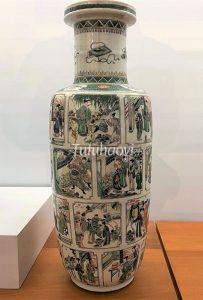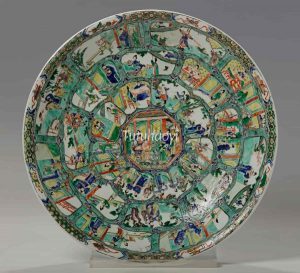Scholar Zhang Embarking on His Journey to Sit for Civil-Service Examinations
张生赶考 (应举登途)
© Tutuhaoyi.com owns the copyright of the description content for the images attached. Quoting all or part of the description content on this page is permitted ONLY IF ‘Tutuhaoyi.com’ is clearly acknowledged anywhere your quote is produced unless stated otherwise. (本页描述内容版权归Tutuhaoyi.com所有,转发或引用需注明 “Tutuhaoyi.com”, 侵权必究, 已注开源信息的条目除外。)
Young scholar Zhang Junrui (张君瑞, also called Zhang Sheng 张生) is the male protagonist in the famous ancient Chinese play, Romance of the Western Chamber (西厢记 Xixiang ji, alternative translation is The Story of the Western Wing). He was commonly referred to as Scholar Zhang. The son of a cabinet minister of the court, he suffered the tragedy of losing both parents. This left him with only his sword and his books for solace and entertainment. Thus, he decided to sit for civil-service examinations. In Episode 2 of the play, he set off on horseback to the capital with his pageboy. The scene (in fig. 1 & 21) depicts the moment when they approached the district of Pudong on the west bank of the Yellow River, in the territory of the Hezhong Prefecture (张生至蒲东).
image identification and literature research: by Dr Yibin Ni
Other episodes in the Romance of the Western Chamber:
Consummation of love from Western Chamber 月下佳期
Yingying Listening to the Qin Zither Playing 莺莺听琴
Yingying receiving good news delivered by the pageboy 泥金报捷
Scholar Zhang getting drunk due to Madame Cui’s broken promise 张生醉酒 (崔母悔婚)
Fig 1-2: bronze-inlaid pewter octagonal vase with cover, 1578, courtesy of Sotheby’s auction house, New York, 23 September 2020, Lot 622
Fig 3: covered round porcelain box with underglaze blue decoration, 1640–1700, courtesy of Ashmolean Museum, University of Oxford, Accession no. EA1978.851
Fig 4-5: porcelain vase with underglaze blue decoration, Shunzhi period (1644–61), Qing dynasty, courtesy of the Metropolitan Museum of Art, New York
Fig 6: close-up from rouleau vase with overglaze enamelled decoration, Kangxi period (1662–1722), Qing dynasty, courtesy of The Guimet Museum, Paris, photograph by Mr JP Kim
Fig 7: rouleau vase with overglaze enamelled decoration, Kangxi period (1662–1722), Qing dynasty, courtesy of The Guimet Museum, Paris, photograph by Mr Riad Kneife
Fig 8: porcelain vase with underglaze blue decoration, Kangxi period (1662–1722), Qing dynasty, courtesy of the Shanghai Museum, China
Fig 9-10: porcelain bowl of a set with overglaze enamelled decoration, Kangxi period (1662–1722), Qing dynasty, courtesy of Groninger Museum, Groningen, The Netherlands
Fig 11-12: porcelain dish of a set with overglaze enamelled decoration, Kangxi period (1662–1722), Qing dynasty, courtesy of Groninger Museum, Groningen, The Netherlands
Fig 13: porcelain plate with overglaze enamelled decoration, Kangxi period (1662–1722), Qing dynasty, formerly in the Marc Michot Collection
Fig 14: gilded porcelain lantern with overglaze enamelled decoration, Kangxi period (1662–1722), Qing dynasty, courtesy of the Victoria & Albert Museum, London
Fig 15: porcelain dish with underglaze blue decoration, Kangxi period (1662–1722), Qing dynasty, formerly in the Robert McPherson collection
Fig 16-17: famille verte porcelain container, Kangxi period (1662–1722), Qing dynasty, formerly in the Bertrand de Lavergne collection
Fig 18: porcelain bowl with underglaze blue decoration, Kangxi period (1662–1722), Qing dynasty, formerly in the Bertrand de Lavergne collection
Fig 19: porcelain square brush holder with overglaze enamelled decoration (detail), Yongzheng period (1723–35), Qing dynasty, courtesy of the Shanghai Museum, China
Fig 20: famille rose porcelain plate, Yongzheng period (1723–35), Qing dynasty, courtesy of Galerie Nicolas Fournery collection
Fig 21: woodblock printed illustration of the play Romance of the Western Chamber, printed in 1498 in Beijing, from Ming kan xixiangji quan tu (Complete Set of Illustrations of Romance of the Western Chamber), Shanghai: Shanghai Fine Arts Publishing House, 1983, p. 21




















